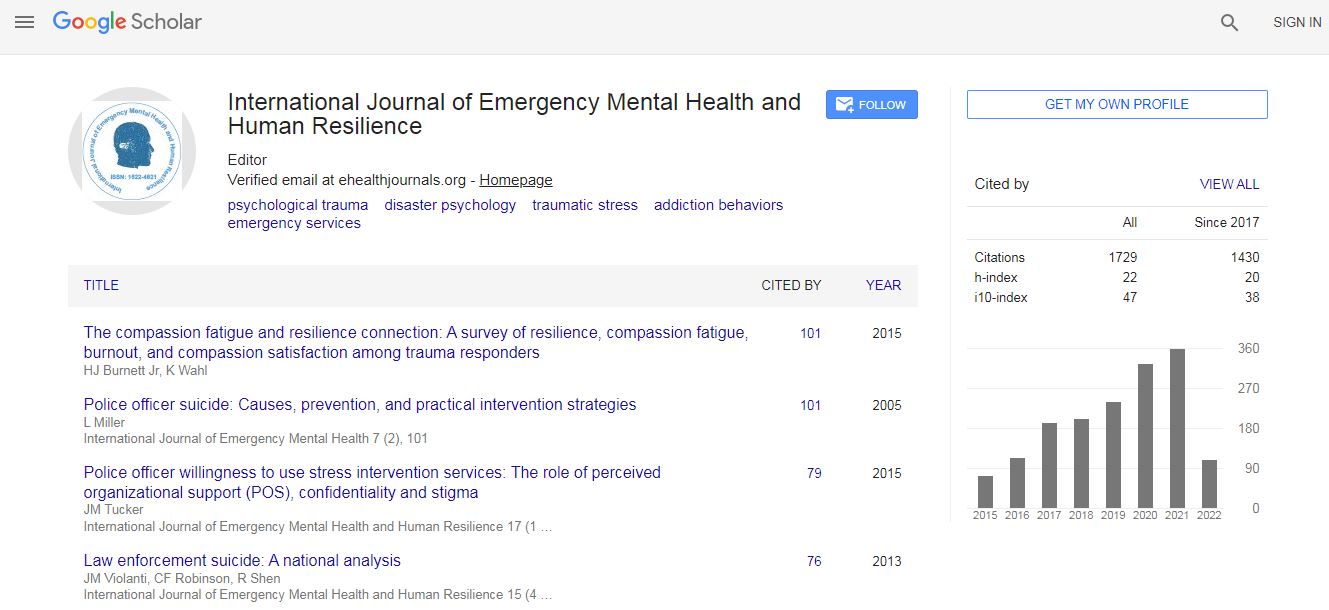Our Group organises 3000+ Global Conferenceseries Events every year across USA, Europe & Asia with support from 1000 more scientific Societies and Publishes 700+ Open Access Journals which contains over 50000 eminent personalities, reputed scientists as editorial board members.
Open Access Journals gaining more Readers and Citations
700 Journals and 15,000,000 Readers Each Journal is getting 25,000+ Readers
Google Scholar citation report
Citations : 4948
Indexed In
- Index Copernicus
- Google Scholar
- CiteFactor
- Publons
- Pubmed
- science Gate
- scispace
- world cat
Useful Links
Related Subjects
Share This Page
Infective Endocarditis in Tetralogy of Fallot Complicating Brain Abscess
38th International Conference on Psychiatry and Mental Health
Ramachandran Muthiah
Morning Star Hospital, India
ScientificTracks Abstracts: Int J of Emer Ment Health
Abstract
Infective endocarditis is a serious and fatal complication in congenital heart disease. Patients with congenital heart disease have structural changes that create turbulence and shear force in blood blow that disrupts the endocardium, exposing the subendocardial collagen and extracellular matrix. The resultant inflammation causes endothelial cells to express ├?┬▓1 integrins, which bind circulating fibronectin to the endothelial surface and production of tissue factor, deposition of fibrin, and platelet adherence lead to hemostasis and pathogenic organisms may settle in and infect the endocardium in these areas. With sequestration and limited blood supply to a damaged area, formation of vegetation and / or abscess may occur. These friable vegetations have the capability of causing emboli, which may result distal abscess formation, especially in the brain. The risk of infective endocarditis in cyanotic CHD is more than six times the risk compared to those in acyanotic CHD. Cyanotic heart disease accounts for 12.8-69.4 % of all cases of brain abscess with the incidence being higher in children. The risk of brain abscess complicating cyanotic CHD (congenital heart disease) is inconstant, but is more common after two years of age and increases consistently until the age of 12 years. Of all the patients with brain abscess and cyanotic congenital heart disease, TOF (Tetralogy of Fallot) is the most common in association (13-70 %) of cases. In Fallot├ó┬?┬?s tetrad, Bing and associates have shown that the shunting from right-to-left occurs in the absence of failure, owing to the overriding of aorta. When a reversal of flow is said to occur, favouring paradoxical embolism and paradoxical brain abscess stands second only to bacterial endocarditis. Pulmonary circulation represents a potential filtering apparatus for systemic bacterial pathogens. In patients with right-to-left shunts, absence of pulmonary phagocytic clearance of pathogens can occur and the ischemic injury from hypoxaemia and polycythaemia, resulting low perfusion areas (microinfarcts) in the brain which may act as a nidus for infection. In the development of brain abscess, inoculation of an organism is required into the brain parenchyma in an area of devitalized brain tissue or in a region with poor microcirculation and the seeded microorganisms can sustain growth and multiply to form abscess. Brain abscess begins with a localized area of inflammatory change referred to as cerebritis. This early stage of infection is characterized by increased blood vessel permeability without angiogenesis. When unrecognized, this process will progress to an immature capsular stage and then to brain abscess, a condition defined by an area of parenchymal infection containing pus encapsulated by a vascularized membrane.Biography
Ramachandran Muthiah is Consultant Physician & Cardiologist, Zion Hospital, Azhagiamandapam and Morning star hospital, Marthandam, Kanyakumari District, India. Completed M.D. in General Medicine in 1996, D.M. in cardiology in 2003 under Tamil Nadu Dr. MGR Medical University, Chennai, India. Worked as medical officer in Rural health services for 5 years and in teaching category as Assistant Professor at Madras medical college, Coimbatore medical college, Thoothukudi medical college and Professor at Dr. SMCSI Mission hospital & Medical college, Karakonam, Trovandrum and Azeezia Medical college, Kollam. Published many papers in Cardiosource, American College of Cardiology Foundation, Case Reports in Clinical Medicine (SCIRP) and Journal of Saudi Heart Association. Special research on Rheumatic fever and Endomyocardial fibrosis in tropical belts, Myxomas, Ineffective endocarditis, apical hypertrophic cardiomyopathy, Ebstein’s anomaly, Rheumatic Taussig-Bing Heart, Costello syndrome and Tetralogy of Fallot.

 Spanish
Spanish  Chinese
Chinese  Russian
Russian  German
German  French
French  Japanese
Japanese  Portuguese
Portuguese  Hindi
Hindi 